The Clints of Dromore
(NX 542 641) 200m S facing, (SMC Lowland Outcrops 2004, page 202)
Impressive when viewed from the road, the Clints of Dromore are disappointingly found to be broken and easy-angled at close quarters. Nevertheless this is a good, quick drying, sunny and sheltered venue, particularly suitable for those looking for lower grade routes and a handy spot for winter cragging. Adders for whom a wary lookout should be kept also seem to appreciate it. NB:The Clints of Dromore are part of the Cairnsmore of Fleet National Nature Reserve, and are used by several species of protected nesting birds. Because of this, Scottish Natural Heritage ask climbers to observe a seasonal Bird Restriction (15th February to 30th June) to avoid disturbing the birds. However, the nest sites vary from year to year, so to obtain the latest details, please check the MCofS website, or phone the NNR office (01557 814435).

The Clints of Dromore (click the photo to see the main buttresses)
From Gatehouse of Fleet follow the B796, then go right on to a minor road and track leading via a visitor centre to the viaduct across the Big Water of Fleet. Walk north along the old railway for a short distance to where a stile gives access to the crags. Follow the path up towards the cragto the remains of an old wall with a gate in the fence to its left. Continue to the remains of a second old wall at a point where the fence almost reaches the foot of the crag (15mins). 200m beyond this is a prominent black-streaked slab with a large flake boulder at its foot. This is BLACK STREAKER SLAB. Right of Black Streaker Slab is a broad grassy gully and right of this is the WHITE SLAB AREA which contains lots of broken rock but little climbing of great note. Some of the lines have proved difficult to locate - these are indicated with a question mark after the name.
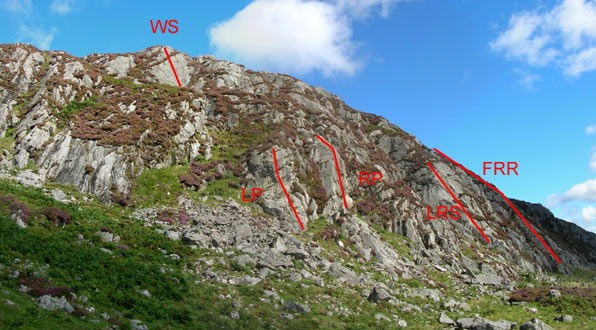
| WS |
White Slab |
VD |
LRS |
Left Right Slab ? |
VD |
| LP |
Left Pillar |
MS |
f/a SJH Reid (solo) 2006 |
FRR |
Far Right Rib ? |
M |
| RP |
Right Pillar |
MS |
f/a SJH Reid (solo) 2006 |
|
|
BLACK STREAKER SLAB gives several easy but rather bold routes.
1: Flake Climb (HS)
2: Black Streaker (VD)
3: Left Rib (S)
However, John and Linda Biggar have climbed four routes on this slab and another two up to its left.
1: Far Left Rib 20m V Diff *
Start at the foot of the juggy rib and climb it up and leftwards on satisfyingly big holds.
J Biggar and L Biggar, 13th September 2009
2: Dark Slab 20m V Diff * Much better than it looks. Start as for Far Left Rib, climb the slab for 5m then the steep back wall on the left.
L Biggar and J Biggar, 13th September 2009
3: Left Rib S *
4: Black Streaker VD *
5: The Return of the Black Streaker HS**
6: Flake Climb HS
Some 150m left of Black Streaker lies CENTRAL BUTTRESS which provides the most continuous area of rock on the crag. A useful identification point is that the fence directly below the crag drops back down to the forest. Belays need searching for - a Hex 9 is useful. The climbs here are almost 50 metres in length.
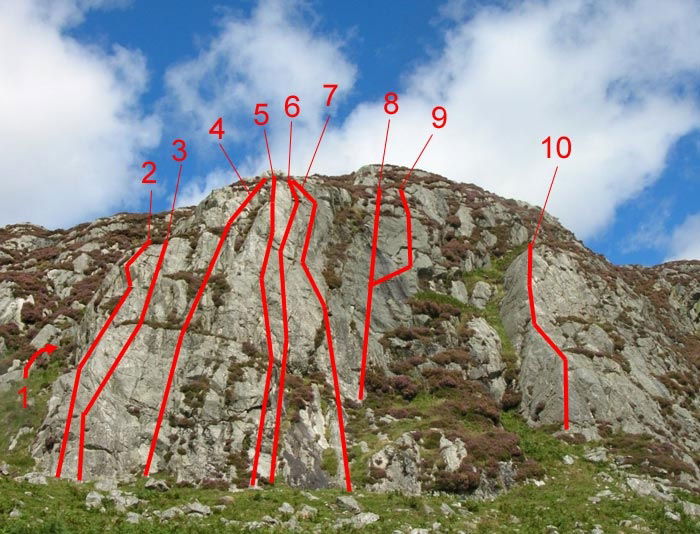
Central Buttress Area, The Clints of Dromore, showing the main lines
| 1 |
It Tolls for Thee |
VS |
6 |
Quoth the Raven |
HVS* |
| 2 |
Left Edge |
VD |
7 |
The Comfy Chair |
VS |
| 3 |
Left of Centre |
VD |
8 |
The Spanish Inquisition |
VS |
| 4 |
Just Left of Centre |
D |
9 |
Direct Finish |
HVS |
| 5 |
Central Buttress |
S* |
10 |
Spare Rib |
MS * |
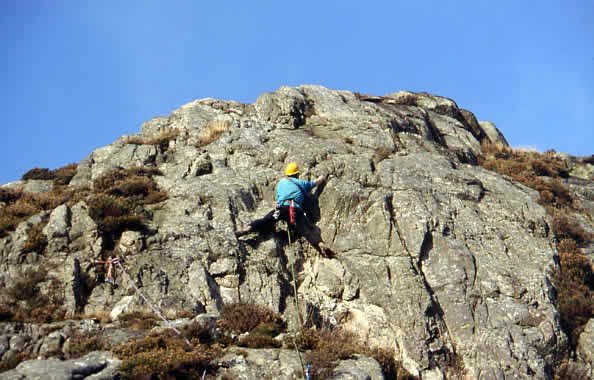
John Biggar on Central Buttress, which finishes up the rib. Quoth the Raven takes the crack to the right, then the slab above.
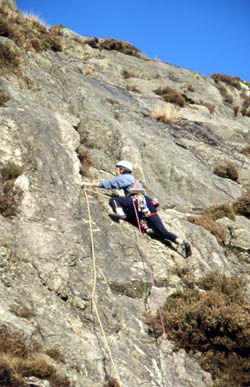
Chris King on Spanish Inquisition.
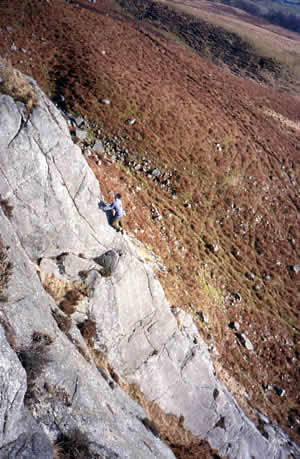
Al Hewison soloing Spare Rib.
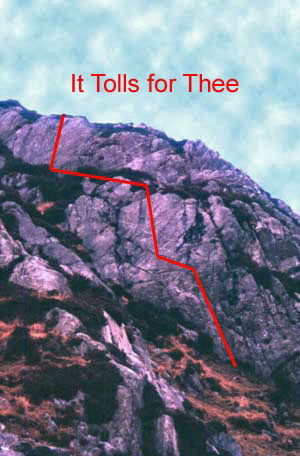
It Tolls for Thee 40m VS 4b*
A bold route on great rock. On the left flank of Central Buttress, are two large slabs. One above and left of the other. Start 10m up left from the start of Left Edge, just below where the grassy bank steepens into a gully. Climb steep cracks and pull out left onto the lower slab. Traverse left into its centre and climb straight up to a large heather ledge. Traverse left to the next large slab (Friend 3 near start) which is climbed up the centre without further protection.
S Reid, C King, 5th Feb 2006
Round and up the wide gully to the left of Central Buttress are two short slabs, one above and left of the other. These give excellent short problems at S and VS respectively.
Some 300 metres to the left of Central Buttress is the Deep Nick of Dromore, an open wide grassy gully. On the right of the entrance to this is a fine short slab from whose bottom right corner starts the enjoyable Diagonal Line (D 10m). The other obvious lines on this slab have also been climbed, all are of similar standard.
JIGSAW BUTTRESS
Just left of the Deep Nick of Dromore (and about 100m right of the Black and White Walls) is a tall slim broken buttress with some dead trees growing out of it on its left-hand side.
Jigsaw 50m VS 4c
Start on the right side of the buttress, up a grass slope to the right of a large sloping roof. Gain a horizontal crack and hand-traverse leftwards above the lip of the roof to a ledge. Follow the ridge above to the left-hand and lower of to large grass ledges under the steep headwall. Climb the wall above (crux), just left of the rib. It looks possible to finish up the right-hand wall above the upper ledge at an easier grade this would probably reduce the route to Severe.
C King, S Reid, 5th Feb 2006
Photo Right: Jigsaw Buttress
Some 400m to the left of Central Buttress is a steeper though much shorter wall (15m) of excellent clean rock. These are the BLACK & WHITE WALLS.
The buttress is split by the central left-facing Honeysuckle Groove. To the right of this groove is WHITE WALL, to the left is BLACK WALL, the latter being sub-divided into three distinct black slabs by slim grooves.
Belays are scarce, the best being a crack just right of a detached block directly above Cupid's Bow (Friend 1.5 under the roof too). It is best to set up a belay at the start of the day and then keep abseiling back down.
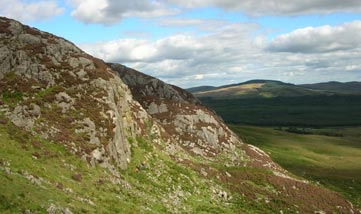
The Clints of Dromore, the Black & White Walls on the left.
|
BLACK & WHITE WALLS
|
| 1 |
Once Bitten |
VS |
8 |
Make My Day! |
E1 ** |
| 2 |
Cupid's Arrow |
VS |
9 |
Sheer Cupidity |
S |
| 3 |
The Climb with No Name |
E2 |
10 |
Honeysuckle Groove |
VS |
| 4 |
Cupid's Bow |
E1 * |
11 |
White Arete |
MS |
| 5 |
Right-Hand Finish |
E2 |
12 |
Sweet Heart |
HS |
| 6 |
Do You Feel Lucky? |
E2 |
13 |
White Scoop |
VS |
| 7 |
Stupid Cupid |
VS ** |
14 |
The Notch |
HVS |
Once Bitten 12m VS 4c
Climb the steep juggy wall left of Cupid's Arrow, stepping right at its top, and then tunnelling up through the heather cornice.
Stephen Reid, Chris King, Sally Baxendale, 7th September 2006.
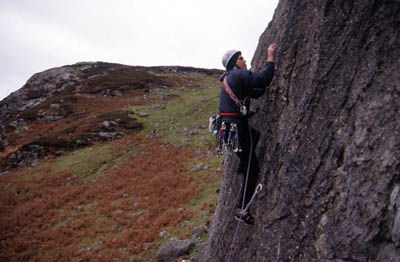
Al Hewison on the first ascent of Cupid's Arrow.

Stephen Reid on the first ascent of Stupid Cupid.
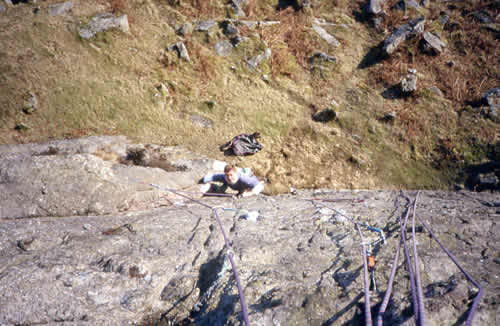
Al Hewison on the first ascent of Cupid's Bow.
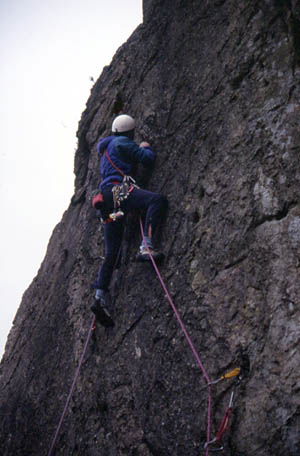
Chris King on the first ascent of the excellent Make My Day!.
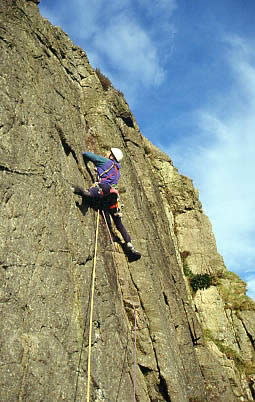
Chris King repeating Cupid's Bow, a technically easy, but rather bold route.
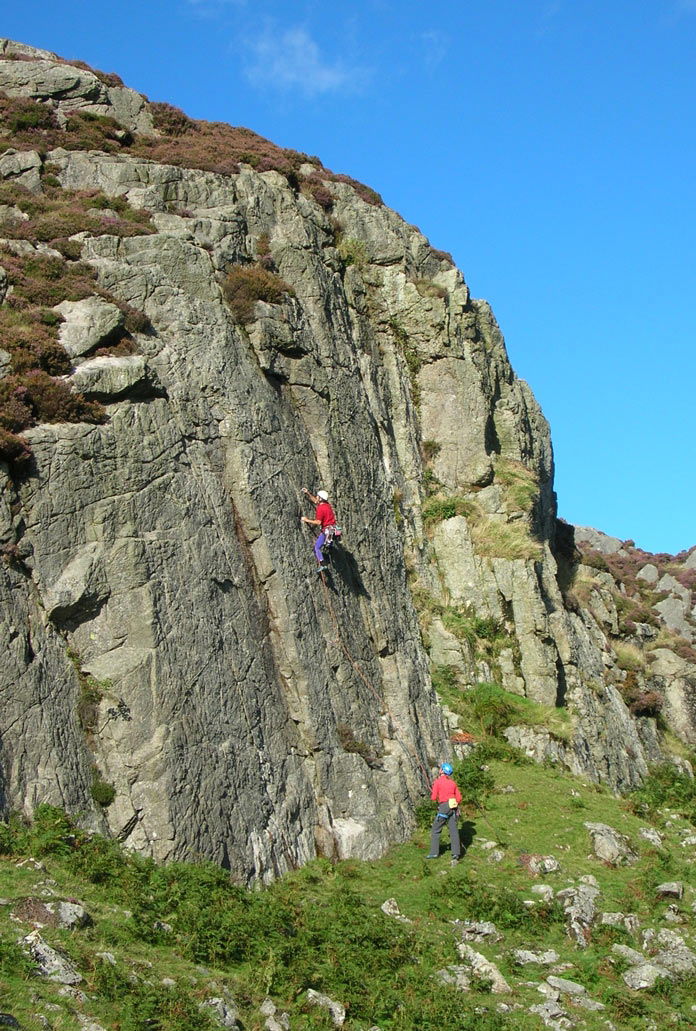
Chris King and Sally Baxendale on Do You Feel Lucky? (E2)
Left of the Black and White Walls, and just up right from Far Buttress, is Dome Slab.(15m, Stephen Reid (solo), 7th September 2006) which can be climbed anywhere at a very pleasant VD* . Unfortunately there is no belay.
FAR BUTTRESS
This is the small buttress 100m to the left of the Black and White Walls. It has a large clean ledge high up in its centre, and a lower heather ledge on the right. The rock is a little friable.
Under The Far Away Tree 10m HVS 5a
A route with a rather serious feel, and quite hard for the grade. Starting on the left side of the buttress, climb up into a shallow scoop and make a rising traverse rightwards to gain the large upper ledge with difficulty. Pull straight over the centre of the roof and finish up a short groove. Belay immediately.
S Reid, C King, 5 th Feb 2006
The right-hand rib of this buttress has also been climbed (VD). It gives a few metres of rock followed by lots of grass and no belay.
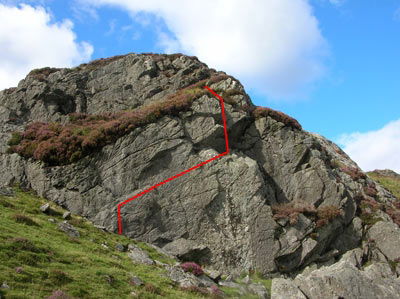
Far Buttress
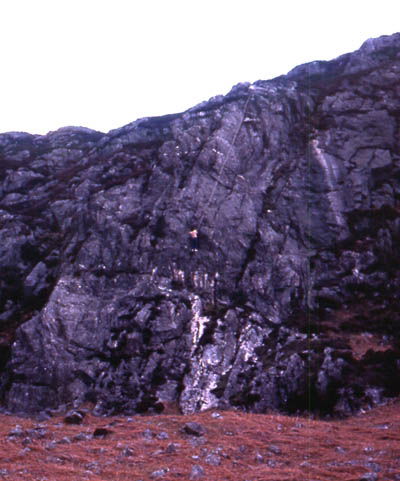
Photo Above: Kelvin Donaldson belaying 'Tich' Carmichael on the first ascent of Central Buttress, 7th May 1978. Andrew Fraser who led the climb had just descended to take the picture. (Andrew Fraser).
HISTORY
The history of climbing at the Clints of Dromore is very vague. Gordon Waldie and friends certainly climbed here in the '50s though they detailed none of their routes. They recorded finding a bootnail at the crag which would indicate earlier climbers.
The first climbs recorded were those of Andrew Fraser, Kelvin Donaldson and Alan 'Tich' Carmichael in May 1978, and these included Central Buttress and Spare Rib. Fraser and others continued to visit the crag, and on 25th of August 1991 he and Robin McAllister, who had made the first ascent of Ancient Mariner at Meikle Ross that morning, climbed the clean slab to the right of Central Buttress to give The Spanish Inquisition, so called because "Nobody expects the…" (Monty Python addicts will know the phrase).
Few of these climbs made the 1994 SMC Lowland Outcrops guide due to the (mistaken) opinion in the editorial office that the crag was too broken to offer any worthwhile climbing, and it wasn't until 2001 that Stephen Reid took an interest in the place with a view to describing it fully for the 2004 edition of Lowland Outcrops.
Many of the climbs that he, John Biggar, Chris King, Al Hewison, Jilly Reid and Sally Baxendale recorded then will almost certainly have been climbed before, but it is likely that the development of the Black & White Walls was completely new. What they found was that, though much of the climbing at the Clints is broken, the rock is superb and very quick to dry, and the crag has the only high concentration of easily accessible lower grade climbs in the Galloway Hills - and for that reason alone is well worth describing in full. In 2006 Reid and King tidied up a few odds and ends.